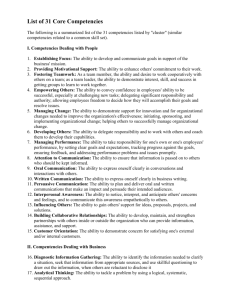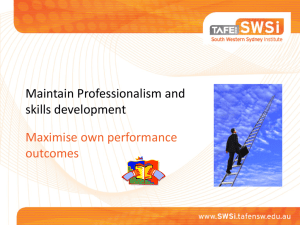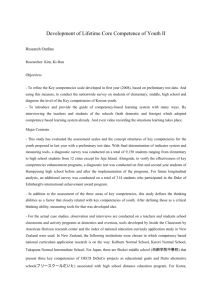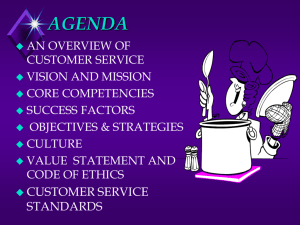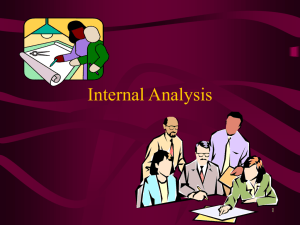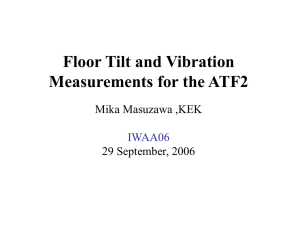Administrative Technologies
advertisement
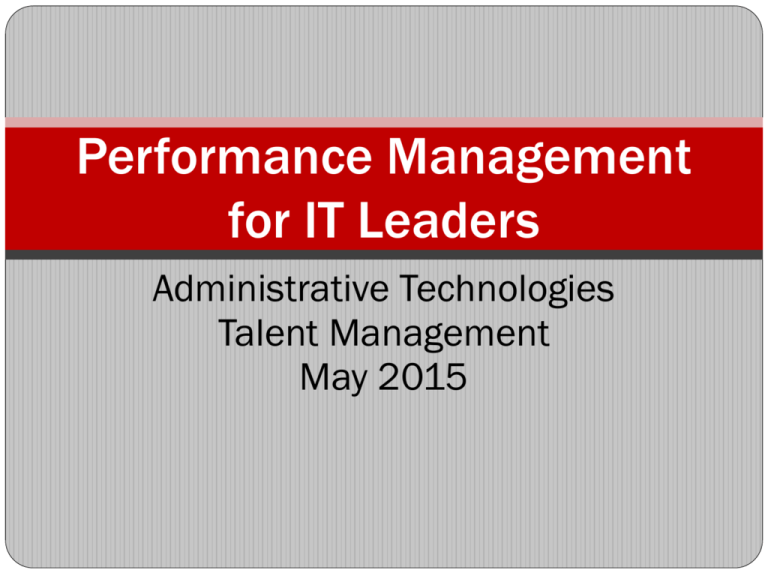
Performance Management for IT Leaders Administrative Technologies Talent Management May 2015 What is Performance Management? Why Manage Performance? Differentiate & reward top performers; address & resolve poor performance Focus and align efforts in support of department and University goals Increase employee engagement Increase job satisfaction and therefore retention Performance Management Life Cycle Core Competencies AT Development Plan Annual Performance Evaluation Job Description Goal Setting & midpoint check-up Core Competencies Core Competencies are the innate qualities required for a position These are the “must have” characteristics for an individual to be successful Once Core Competencies are identified, they can be used to write an accurate and comprehensive job description/posting A better job description/posting results in a better hire! Staff Core Competencies: Attention to Communication Building Collaborative Relationships Customer Orientation Fostering Innovation/Continuous Improvement Initiative Flexibility Reliability Managing Change Fostering Diversity Technical Expertise Leadership Core Competencies: Collaborative Leadership * Managing Performance * Coaching * Visionary and Strategic Thinking * Establishing Focus Fostering Teamwork Interpersonal Awareness Judgment *Specific to AT Leadership Team Job Descriptions Use the Core Competencies identified for a position to guide the process of writing a job description A detailed and accurate job description/posting should result in a pool of qualified candidates Use competency-based interview questions to focus on how the candidate has demonstrated a competency in the past Steps in Writing a Job Description: 1) 2) 3) 4) 5) 6) Establish core competencies for the position Review job descriptions for similar positions from other departments or other universities The IPATHE Talent Management group will share this information; HR also has contacts at other universities Brainstorm the responsibilities and duties of the position Outline a “day or year in the life” of the position using percentages for each duty Review with HR to determine the appropriate classification Why Set Goals? Encourage & motivate employees Increase productivity & efficiency Hold employees accountable Demonstrate how individual efforts support department and University goals Inspire & guide professional development Goals & Performance Standards Educating Illinois IT Strategic Plan & VPFP Strategic Plan AT FY16 Goals Individual Employee Goals Developing SMARTER Goals: S M A R T E R •Specific •Measurable •Attainable •Relevant •Timely •Evaluate •Reevaluate Goal-Setting Recommendations: Involve the employee in goal-setting, particularly for professional development goals Schedule time to discuss with the employee and be present (no distractions/interruptions) Use the Goals & Performance Standards form to make Performance Evaluation time easier! Don’t forget to schedule a midway checkpoint to address goals that have been completed, changed or are no longer applicable! Annual Performance Evaluations Use Performance Evaluations To…. Challenge high performers Encourage and guide improvement Acknowledge accomplishments Align employee to organizational goals Evaluation Recommendations: Don’t wait until the end of the year to gather information! Utilize available tools to make your job easier: GPS (Refer back to Goals & Performance Standards) Drop file (Keep updated regularly throughout the year) Set aside quiet time to complete evaluations Provide specific and honest feedback Schedule time to discuss with the employee & be present (no distractions/interruptions) AT Development Plan: PURPOSE: Provide guidelines, resources and tools to AT staff, enabling them to formally progress to a higher level of responsibility within his/her current position OBJECTIVES: Provide a framework for AT staff to further develop skills & competencies Address potential issues within the broad IT classifications Improve employee retention & job satisfaction Provide foundation for succession planning ATDP Continuum Development Plan Details: An AT Development Plan can encompass both long and short-term goals The AT Development Plan is an optional program separate from annual Goals & Performance Standards; the ATDP should include action items above and beyond the scope of the employee’s current responsibilities The ATDP is separate from Annual Performance Evaluations; an employee should not be disciplined for failure to complete action items included in the ATDP. ATDP Forms & Processes 1) Eligibility Checklist – examples include: passing probationary periods, having overall rating of “Meets Expectations” or higher on evaluation, cannot be under disciplinary action, etc. 2) Assessment – to determine current level on the ATDP continuum 3) Worksheet – includes sections for core and rolespecific professional competencies, professional development, and certifications 4) Action Items – should include timeframes, be challenging, and be consistent Questions? #1 Core Competencies #5 AT Development Plan #4 Annual Performance Evaluation #2 Job Description #3 Goal Setting & Midpoint Check-in

